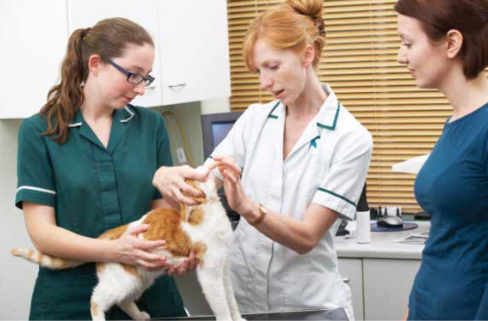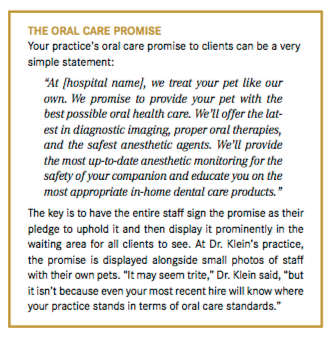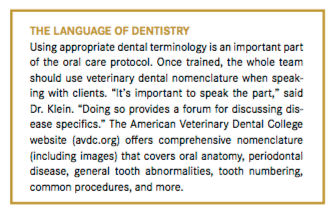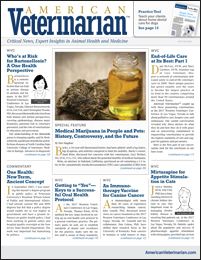WVC 2017: Getting to "Yes" - Keys to a Successful Oral Health Protocol
At WVC 2017, Thomas Klein, DVM, outlined the key steps involved in setting up an oral health care protocol in a general veterinary practice.

At the 2017 Western Veterinary Conference in Las Vegas, Nevada, Thomas Klein, DVM, outlined the key steps involved in setting up an oral health care protocol in a general veterinary practice.
The primary goals, he said, are to establish standards of dental care excellence for the practice, make sure the entire staff is aware of those standards, and ensure that every staff member who speaks with clients can (and does) discuss dental disease with knowledge and authority.
Every hospital will enter the protocol at different levels of knowledge, interest, experience, and ability, Dr. Klein noted, and that’s fine. The key is getting everyone on board and educated. “If your entire team understands the practice’s oral care standards of excellence, then they are going to hold the practice’s veterinarians accountable for maintaining those standards,” he said.
Dr. Klein, who co-owns East Hilliard Veterinary Services in Hilliard, Ohio, has performed oral procedures on animals ranging from dogs and cats to rodents and rabbits to polar bears and apes. “Seventy-five percent to 80% of your canine and feline patients over 2 years of age are affected by dental disease,” noted Dr. Klein. “No other disease has that kind of predominance level.”
“Ours went from a very standard general practice to a focused dental practice,” Dr. Klein said, and the return on investment has been immense. “In addition to the obvious benefit of healthier patients, there are many spinoff benefits, including added technological improvements, communication improvements, staff enjoyment, and staff empowerment.”
Establish Standards of Excellence
Establishing standards of excellence in oral care is the first step in setting up your protocol because standards, Dr. Klein noted, allow for consistency of oral care services among the entire team. “Getting clients to ‘yes’ is the goal, and having set standards enables the entire team to know how to refer cases to other team members who are more focused on dentistry.”
Standards also make it more likely that any staff veterinarians who are not interested in dentistry will recommend dental disease treatment for their patients. “Not every doctor in the practice needs to be an expert in dentistry,” said Dr. Klein, “but they do need to be aware of the practice’s abilities and oral care principles."

Technicians can play an important role here as well by making relevant notes in the patient chart regarding treatment needs discussed during the exam. Because the technician knows what is routinely required for a particular dental problem, he or she can simply make a note and ask the doctor to sign the chart.
“Compliance will go way up,” said Dr. Klein, if your support staff, particularly those who have been there the least amount of time, know what the standards are and know that all the practice doctors are at least going to recommend the right care. “Doctors will be more likely to recommend the right care if the entire team knows what that care plan should look like,” he said.
Create an Oral Care Promise
Once you’ve set the oral care standards for your practice, it’s time to get the team fully involved. “Start with an oral health care promise,” suggested Dr. Klein, “which is a simple statement that all staff members sign.” Schedule a staff meeting or team outing to talk with the entire staff about the planned oral care protocol and have each one sign the promise.

To implement the promise and move your oral care initiative along, assign a few staff to spearhead the protocol. In a larger practice, 2 or 3 people can fill this role—1 doctor, 1 technician, and 1 client care representative (eg, head or midlevel receptionist). In smaller practices, it’s not necessary to involve a veterinarian from the start; a technician and client care representative can get the ball rolling. “In my practice,” Dr. Klein recalled, “we started with an associate (who had more time than me), a technician who was interested in dentistry, and a receptionist who liked dentistry but didn’t know much about it.”
This group works because clients will get the deep knowledge and advice about protocols from the technician, and the receptionist—who has the most client contact—can then reinforce the recommendations. “If your receptionist is well trained on oral home care,” said Dr. Klein, “you’ll dispense more products than if just the veterinarian or technician were talking about it to the client.”
Determine Your Practice's Proficiency Level
Once you choose the people who will initiate the protocol, find out how familiar the practice is overall with dental disease, including equipment and product knowledge. Is someone on staff already somewhat advanced with dental techniques, or is your practice just getting its first dental imaging device or high-speed drill? “There are different levels of knowledge, experience, and interest among staff,” Dr. Klein reminded the audience. “The key is to get the rest of the staff up to the recognition level—but not necessarily the ability level—of the gung-ho technician or veterinarian.”
Educate the Whole Team
Once you know where you are as a practice, engage and educate your entire team, advised Dr. Klein. There are a number of avenues you can take for teaching and training, such as inviting a local veterinary dental specialist, if there is one in your area, to provide oral care education and training.
Alternatively, he suggested, you can consider a comprehensive oral care educational program like that offered by Midmark Academy. “They come to your office, review your equipment, and talk about all aspects of periodontal disease,” he explained. They recommend closing the practice for an entire day or doing the training on a weekend. “After about 3 hours with a Midmark veterinarian, my receptionist was using dental lingo and could identify teeth on x-rays,” said Dr. Klein.

Again, he noted, it’s your front office staff who are most critical in guaranteeing the success of your oral health pro- tocol. “It’s amazing how much dental work we do now because the staff knows so much,” said Dr. Klein.
Of course, veterinarians know that pet care recommendations often must be made multiple times before a client follows them. If dental care recommendations are reinforced with multiple messages from multiple people on multiple visits, then compliance will increase greatly. “When the receptionist can talk specifics about dental anatomy, disease stages, and bone loss,” noted Dr. Klein, “the client receives multiple messages and often says, ‘OK, I guess I have to do this because everybody is saying it.’ ”
Become Masters of Anesthesia
Many clients are reluctant to have their pet undergo dental procedures because they fear the potential dangers of anesthesia. “They may have had a bad experience with a pet in the past, or they may have a neighbor or friend whose pet became very ill or died following an anesthetic episode,” said Dr. Klein.
That’s why it’s so important to ensure that you offer the safest anesthetic protocols available, including effective monitoring by support staff, said Dr. Klein. “You need to be able to apply specific anesthetic protocols that match patient needs, taking into consideration the pet’s age and concomitant health conditions.” Again, it helps when your front office team can address clients’ anesthesia concerns.
With the types of anesthetic regimens and the array of induction agents we have today, noted Dr. Klein, there really are very few patients that are not appropriate candidates for anesthesia. “As long as you have good protocols and monitoring practices that you’re extremely satisfied with, a protocol you’d be comfortable using on your own pet,” he said, “then your patients will be safe in getting the treatment they need.”
